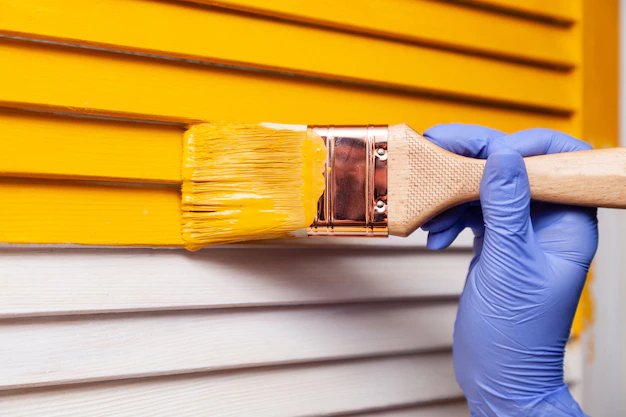If you love to craft but don’t enjoy the mess of messy mediums that could get on your clothing then acrylic paint on fabric might be a good option for you!
The good news is that you can use acrylic paint on fabric. Acrylic paint has many advantages over oil and watercolor painting, which is why it’s quickly becoming one of the most popular mediums for painting.
Do you have a favorite article of clothing that you wish you could paint on, but don’t want to risk staining? This informative post will;
- Show you how to paint acrylic paint on any fabric
- Guide you on how to seal acrylic paint on fabric
Let’s get right to it!
Related Reading
- Can You Use Acrylic Paint on Glass?
- Can You Use Acrylic Paint on Leather?
- Will Acrylic Paint Stick To Plastic?
- Can You Use Acrylic Paint on Metal?
- Can You Use Acrylic Paint on Shoes
- Do Acrylic Paints Wash Off?
Acrylic Paint On Fabric For Beginners
Acrylic paint can be used to add color to fabric, but it’s not a good idea to use acrylics on fabrics that are highly delicate or prone to bleeding.
Additionally, Acrylic paints are made with synthetic pigments that have been suspended in water-soluble acrylic polymer emulsion. When the paint dries, it forms a flexible film that won’t crack or peel like oil paints do. The fun part is that acrylic paintings can be cleaned with soap and water, and they can be framed without additional protection layers because they’re not as brittle as oil paints.
How to Paint Acrylic Paint on Fabrics?

The following steps will teach you how to paint acrylic paint on fabrics:
1) Prepare Your Fabric
Prepare your fabric by washing it and drying it flat in the shade for a few hours before painting on it. This will ensure that the fabric is clean and ready for painting.
2) Use an Acrylic Primer Undercoat
- If you want to use an acrylic primer undercoat, then apply two thin coats of primer directly onto the fabric before applying any other paints.
- Allow each coat to dry completely before applying the next coat.
3) Paint Your Fabric
- Mix up some acrylic paint using a palette knife or spatula until it has the consistency of thick cream (about the same thickness as milk).
- Dip a large soft brush into your chosen color and begin brushing it onto your fabric at a 45-degree angle from left to right in one direction only (this will create an even brush stroke).
- Start at one end of your design area and work along until you reach the other end of your design area.
- Next, apply a sealant of your choice for extra protection. You can use a spray sealant varnish.
Major Tip: Use an eye dropper or syringe to apply small amounts of color where you want more pop (such as highlights), rather than directly onto the surface so they don’t mix into each other while still wet (this is especially important when working with multiple colors).
How to Make Acrylic Paint Stay On Fabric?
As a beginner, you can use acrylic paint to paint fabric by using a brush, or you can use it with a stamp. But , if you want acrylic paint to stay on fabrics for a longer time, below are some tips for keeping the paint on your fabric:
1) Use the Right Kind of Paint
The first step is to use the right kind of acrylic paint. Some types of acrylic paint are formulated for use on fabric while others aren’t meant for this purpose at all.
When choosing an acrylic paint that’s appropriate for use on fabric, look for one made specifically for crafting projects ( I recommend Liquitex Professional Acrylic Paints). It’s formulated with extra resins so it can adhere better to fabrics and provide stronger coverage.
2) Choose the Right Fabric
Silk and wool are good fabrics for painting because they don’t absorb much water and dye easily. Cotton is another good choice because it doesn’t wrinkle easily . If you’re working with silk or wool, make sure your fabric is pre-shrunk before you start painting on .
3) Paint Slowly
Always paint slowly and carefully, keeping the brush or stamp in contact with the surface as much as possible to avoid drips or gaps in coverage where the paint can seep through the weave of the cloth. You should also over your work area so that any drips will land on something other than your work surface or flooring. Above all, add another layer of acrylic paint only if the previous layer has dried completely .
Sealing Acrylic Paint on Fabric
There are two ways to seal acrylic paints on fabric: heat setting and air drying.
1) You Can Heat Set Your Fabrics Using an Iron
:max_bytes(150000):strip_icc()/select-correct-ironing-temperature-for-fabrics-2146186-03-f27b3f5156874297b1339dcebd94b11b.jpg)
The heat setting method requires a heat press or an iron that can reach high temperatures, like a hot plate or steamer. You place the fabric face down on your surface and then put a piece of parchment paper over it. This protects your work surface from getting stained by the paint or moisture coming off the fabric as you set it under pressure for about 30 seconds per square inch (psi). The higher the psi rating, the stronger your seal will be and the more durable your piece will be over time.
Heat setting will also help protect your work from water, stains, and damage. The only downside is that you might have less flexibility with the finished product because you can’t wash it easily.
2) Air Drying

Air drying acrylic paints are the most popular for fabric painting. These paints dry to a matte finish and can easily be modified by adding a varnish or sealer.
Air drying acrylic paints work best on light fabrics like cotton, silk, rayon and linen. They should not be used on synthetic fabrics like polyester or nylon because it will not adhere well to them.
How Long Does It Take for Acrylic Paint to Dry on Fabric?
On average, it takes about one to two hours for acrylic paint to dry on fabric. However, this time can vary depending on these factors:
Temperature: Warm temperatures speed up the drying time, while cold temperatures slow down drying time.
Relative humidity (RH): Damp conditions slow down drying time because moisture in air tends to prevent paint from curing completely before it reaches its maximum strength.
Acrylic Painting on Fabric Without Using a Medium?

Using acrylic paint on fabric without medium will give it a rough texture. It also does not retain the color as long as it is expected to. If you want to add a little bit of texture and make it look like it was painted with oil paints, then you should try using Liquitex Heavy Body Artist Acrylic Paints. They come in tons of colors and are great for beginners who want to experiment with their art.
When using acrylic paint on fabric without medium, make sure that you have pre-treated your fabric before painting it. If you don’t do this step correctly, then it may end up looking like there are blotches or streaks on your fabric when it dries.
It’s also important that you don’t add another layer of paint until completely dry. This can cause problems with bleeding .
How to Avoid Bleeding on Fabric?
If you want to avoid bleeds altogether, try using fabric markers instead of paintbrushes or sponges when applying acrylics to your clothing. These markers work like regular markers but come in different colors so you can make designs specific for each piece of clothing or accessory. They’re also great for adding color
Washing Acrylic Paint Off Fabric
When you’re painting with acrylic paints, it’s important to know that the paint will wash off. The best way to remove acrylic paint from fabric is to use a solvent-based remover, alcohol, vinegar or paint thinner. The solvent will break down the acrylic binder in the paint and release it from the fabric.
There are two methods that work for me:
1. I put some Dawn dish soap in a spray bottle with water (about 1/2 cup each) and spray it on the stain; let that sit for about 10 minutes; then launder as usual (I use cold water). This method works great on very fresh stains (within 5 minutes or so), but not so well on old stains. However, if you have an old stain that doesn’t want to budge, try rub isopropyl alcohol on the stain and wash it off.
2. I also use some liquid laundry detergent . Soak in the fabric and then launder as usual . This method works well on old stains too!
Related Post: Do Acrylic Paints Wash Off?
Can You Use Mod Podge as Fabric Medium?
Mod Podge works great for making your own fabric mediums. Just mix equal amounts of Mod Podge and water in a jar, pour into another jar, then add acrylic paint until you get the consistency of paint that you want. You can even add some titanium dioxide for a slightly opaque look if desired.
Can Mod Podge Seal Acrylic Paint on Fabric?
You can use Mod podge to seal your acrylic paint. This is one of its primary uses as an adhesive sealer after acrylic painting on paper or canvas. It will also work on fabric but may not hold up as well in washing machines or dryers if they have high heat settings so keep that in mind when choosing what kind of project you want to do with it!
Tips for Using Acrylic Paint on Fabric
Here are some tips for using acrylic paint on fabric:
- Wash the Fabric Before You Paint It. This will remove any sizing that may have been applied to the fabric when it was manufactured. If there is no sizing present, skip this step and move on to the next one.
- Don’t use too much water when diluting your paints. Use just enough water so that your paint isn’t thick or overly viscous, but still covers well on your canvas or fabric.
- Additionally, use plenty of paint when starting out; you can always add more if needed later.
- Use a palette knife instead of a brush for consistency in application and thickness of coverage (it’s also easier!).
- Moreover, use high-quality artist-grade acrylic paints rather than student-grade ones; they’ll give you better results and last longer than their student counterparts (which tend to dry out faster).
Frequently Asked Questions
What kind of fabric should I use?
It’s important to make sure your chosen fabric is suitable for painting with acrylic paints. Some fabrics can bleed when exposed to water or liquids, so it’s best to test it out first before diving in!
What kind of brushes should I use?
We recommend using synthetic bristle brushes as they are easier to clean than natural hair bristle brushes. Natural hair bristles tend to hold more paint and therefore are more difficult to clean up after each use.
Conclusion
While the idea might seem far-fetched, it’s an absolutely legitimate use for acrylic paint. It doesn’t sound quite as normal as a poster or silk scarf—but it also doesn’t cost much more than those options. And if you love the look but don’t necessarily want to wear it, you can always frame your finished creation and hang it up on the wall.
SOURCES
Can I use acrylic paint on a fabric if I won’t wash the fabric?
https://www.quora.com/Can-I-use-acrylic-paint-on-a-fabric-if-I-wont-wash-the-fabric
What Kind of Paint Can Be Used on Fabric?
https://www.ehow.com/about_5184746_kind-paint-can-used-fabric_.html
Acrylic Paint On Fabric: The Easiest Way To Make And Use It
https://blog.udemy.com/acrylic-paint-on-fabric/
How to Paint on Fabric: 12 Expert Tips
https://www.skillshare.com/blog/how-to-paint-on-fabric-12-expert-tips/
Can You Use Acrylic Paint on Fabric?






